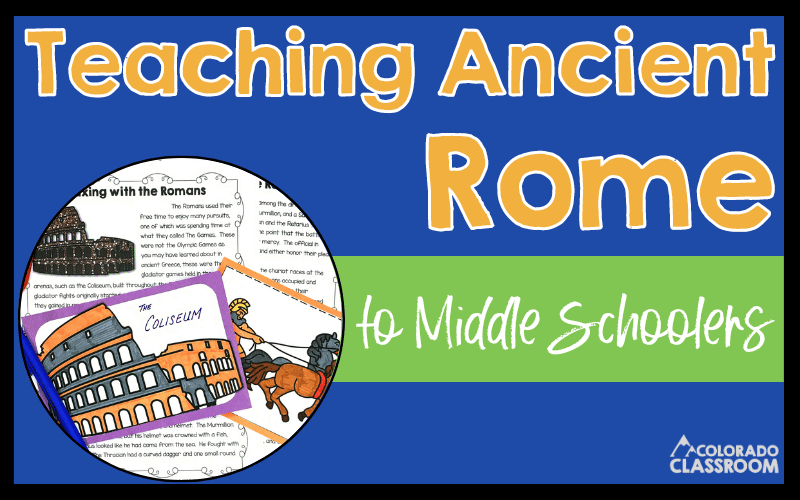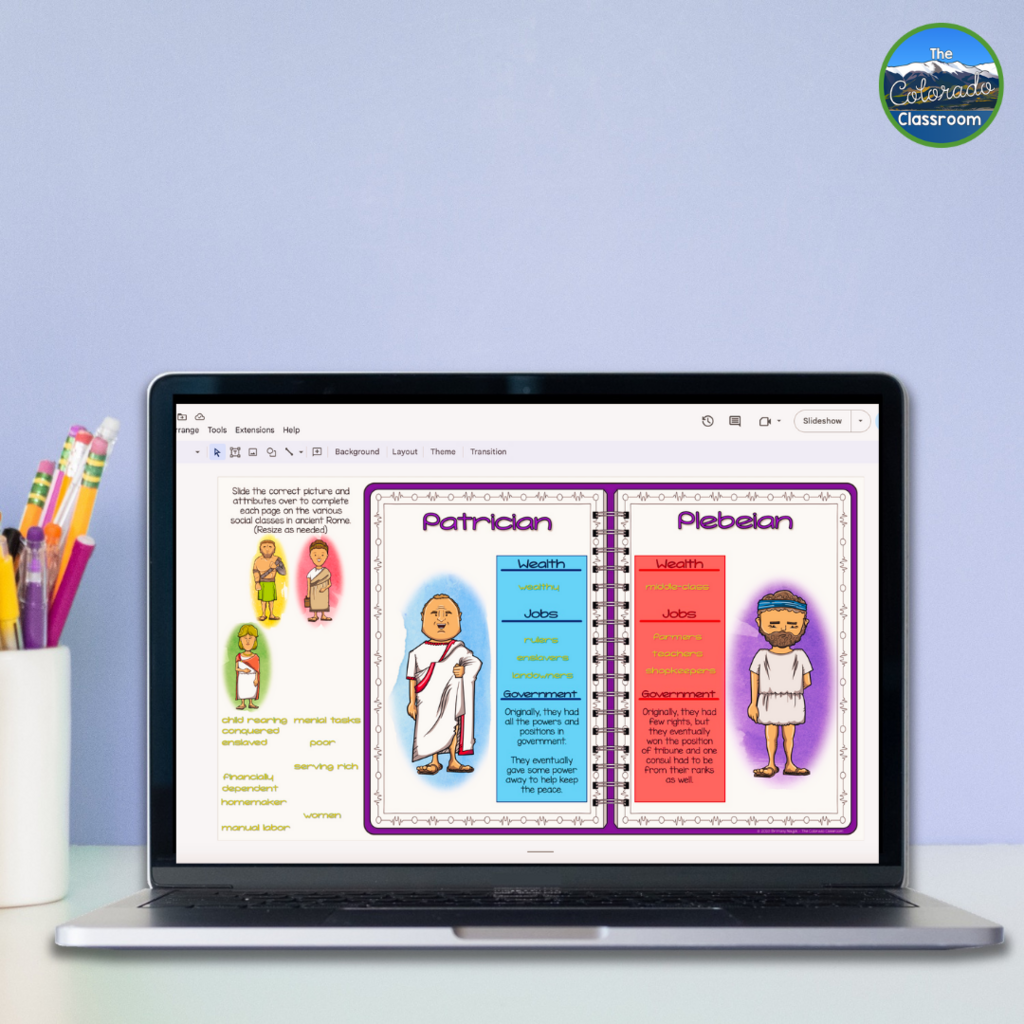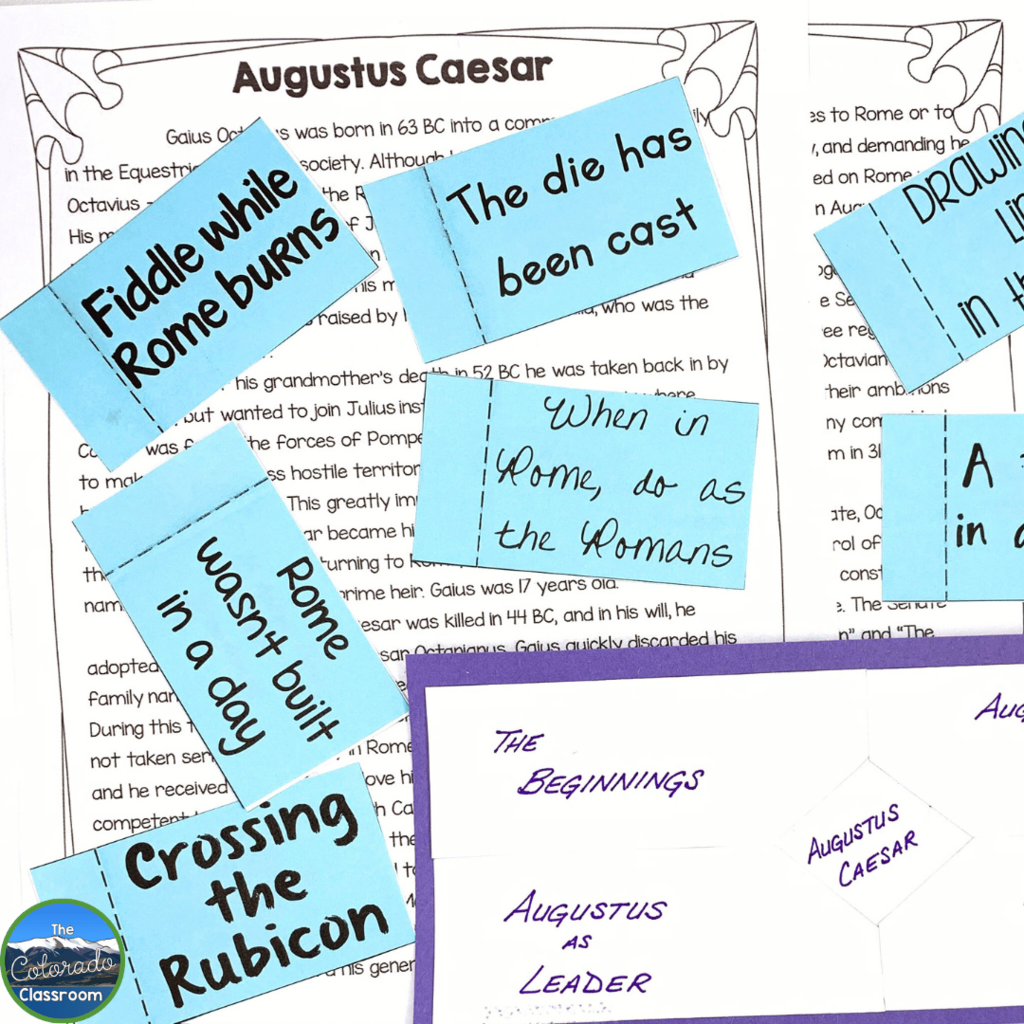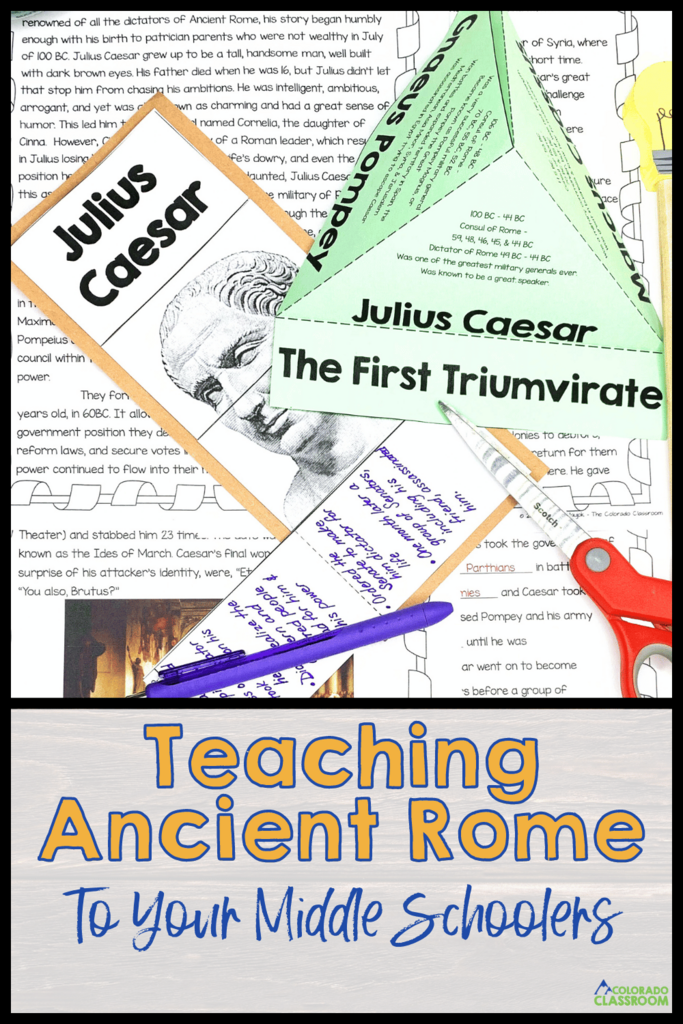Teaching Ancient Rome to Your Middle Schoolers
Ever find yourself knee-deep in a project, pouring your heart into it, and then eagerly anticipating that sweet moment when it finally hits the real world? Yep, that’s me whenever I whip up something awesome for my students. It’s the ultimate reward watching them dive in with the interactive activities all while nailing those learning goals. One of my absolute favorite times of the year is teaching ancient Rome to my middle schoolers.

This unit is the second unit I created specifically for my students. I have tweaked it endlessly and watched it evolve into this epic bundle of resources. Every minute I have poured into these resources has been so worth it because my students have a blast with all the hands-on, interactive activities I cooked up. I’m beyond excited to share this awesomeness with you! Get ready for a time-traveling, seriously engaging lesson party.
Ancient Rome Activities and Interactive Notebook
Before diving into the individual hands-on activities, I want to share a quick behind-the-scenes look at the Ancient Rome Interactive Notebook bundle. Imagine diving into ancient Italy, exploring Roman towns, geeking out over the Punic Wars, getting the lowdown on Julius and Augustus Caesar, and even peeking into the lives of other emperors who rocked the throne. That’s just the tip of the Roman iceberg!
This interactive notebook is a powerhouse of everything in Ancient Rome. History, culture, geography, and society are all rolled into one. I’ve packed it with activities that’ll have your students hooked. Complete lesson plans to make your life a breeze. Eye-popping full-color examples, foldable goodies, readings, two unit tests (take your pick!), a study guide, and, to top it off, two review games to hype up the big wrap-up. The best part? No need for an extra textbook. This unit’s got it all covered!
Teaching Ancient Rome Through Interactive Activities
1. Geography of Italy

The first activity that I use to kick off the unit is the geography lesson for teaching Ancient Rome. Before we dive into the nitty-gritty details, it’s crucial that my students have a solid grip on where we are in the world.
I give students a blank map of Italy to complete, and then I hand out close notes or two-column notes. The format depends on my kiddos’ age and ability. Once materials have been handed out, I pull up the “Get to Know Italy – Geography” slideshow to guide my students through the map activity and note-taking.
Once maps are filled out and notes completed, I decide the geographical knowledge I want my students to master. This leads us into a thorough review session. To ensure everyone is prepped and ready, I provide a study guide. The assessment is a crucial tool that helps me gauge if I’ve laid a strong foundation for the rest of the unit.
2. Teaching Ancient Rome Vocabulary

Now that my explorers are aware of where we are in the world during this unit, the next set of information I want to introduce is the key vocabulary for Ancient Rome. I provide a list of the 12 vocabulary words that are helpful to this unit. I read through them with my class, and we talk about what they mean. Introducing vocabulary at the beginning of our study allows students to use those words, in context, throughout the entire unit.
Once we have reviewed together, I pass out foldables for the flash card holders we place into our interactive notebooks. My students cut and assemble them as soon as they are handed out.
Once the holder is glued in, my students start cutting and folding the flash cards. To keep them safe, they place them in their holders. I’m all about that daily practice, so I throw in some dedicated time at the start or end of class, giving them a chance to flex their vocabulary muscles.
I take my kiddos further by teaching them different vocabulary strategies so that they have opportunities to work with words in different ways. Offering these options lets my students take the reins, pick what suits them best, and dive into the world of word mastery. Plus, they have more exposure to learning the meaning of words, using them in sentences, and looking at synonyms and antonyms.
3. Timeline of Ancient Rome

We can all admit that looking at dates in a textbook can feel pretty meaningless, like in one ear and out of the other. So, I decided to shake things up for my kiddos and give them a hands-on ticket to time travel. I have them create a timeline of the major events that took place during this age.
Each of my students receives 13 pages of the timeline for teaching Ancient Rome. They work on cutting and gluing them together. The first couple of times I guided them through each of the steps of the assembling process. They caught on pretty quickly! As they piece together their timelines, we have a little chat about the BC era and how it works.
Once the timelines are assembled, I guide them through an overview of the history of Rome. I take the lead, guiding them through the ages and events, adding them to our timelines as we go. Sure, this lesson might have a bit of a lecture vibe with me at the front, but the interactive timeline turns it into an engaging lesson for my kiddos!
4. The Roman Republic

In this lesson, I guide my students through the different parts that make up the Roman Republic. My students learn about the role of consuls, the Senate, tribunes, and the Law of the 12 Tables. Usually, I break this lesson into about two days.
On day one, the scissors come out as my students cut out the pieces that make up the Roman Republic foldable. Once those pieces are cut, I lead them through filling out the note portion. Then, we assemble the pieces and glue them into their notebooks. Depending on time, this step may have to wait until the second day.
When it comes to the Law of the 12 Tables, I have my students cut out the trapezoid shape, making sure the axes are on top. We dive into note-taking as a team, unraveling the mysteries of these ancient laws. Then I give time for them to color in the picture before gluing them into their notebooks!
5. Ancient Rome Class Structure

Before jumping into this lesson right away, I want to give a disclaimer that this lesson does include reading about and discussing slavery. The way slavery worked in ancient Rome is presented in an appropriate way for a 6th-grade level. It’s important to note that in ancient Rome, slavery wasn’t tied to skin color or birthplace like it was in early America. In fact, anyone who found themselves in debt in ancient Rome could be sold into slavery to repay the debt. Others were taken prisoners or volunteered to become enslaved.
When it comes to this lesson, I have my students read through the Roman Class Structure reading. This gives them a foundation of the three main classes from top to bottom: patricians, plebians, and enslaved. I make sure to use the discussion questions to help guide their thinking and understanding as we read.
After our reading, I’ll hand out the pieces to the Roman Class Structure Mix and Match foldable. My students work on cutting these pieces out. I love this activity because I can easily differentiate for my different learners. One version has all the government information written out, while another version is fill-in-the-blank. My students are then tasked with matching the definition to the correct class.
At the end of this lesson, I hand out a writing activity to reflect on the different class positions. They think about which position in society they would want to have if they lived during that time. They state their class and provide multiple reasons supporting their choice.

If you are looking for a digital interactive version, you are in luck! The Ancient Roman Class Structure Google Slides activity allows your students to interact with the text with drag-and-drop pieces and text boxes to record important responses to questions. Your students will have a chance to read, highlight text, and discover new vocabulary. Then, they’ll practice the new information by matching the characteristics of each social class by moving descriptive details to the title of the correct group. It’s a digital interactive notebook that is sure to keep students engaged and learning.
6. Ancient Rome Life in a Roman Town

I’m all in for anything that gets my students buzzing with excitement. Let me tell you, this Life in a Roman Town mini-book activity is a real crowd-pleaser! There’s just something about those tiny books that reels them in, and I’m here for it!
As a class, we read the article “Life in a Roman Town.” While reading, we’ll make comparisons about how today’s society differs from Ancient Rome. I’ll jot down our comparisons on the board as we go to provide that visual for my learners.
After reading, I give my students the pieces they need to make their Life in a Roman Town mini-book. They cut and fold their mini-books. Once those are assembled, I guide them through the Life in a Roman Town slideshow. As we go, they fill in notes as they learn about living conditions, food, achievements, the Forum, and roles of boys and girls.
7. Relaxing with the Romans

In this lesson, I explore with my kiddos how the Romans enjoyed themselves through entertainment. We read together the article Relaxing with the Romans. In this article, we talk about the two popular ways the Romans would relax. As we read, they learn about the gladiator games that were held in places like the Coliseum and their other favorite activity, chariot races!
I hand out the Coliseum foldable and the Chariot Racing foldable that my students fold in half. Using the article, we jot down the must-know details and fascinating facts on the correct foldable. We write any facts about the gladiator games on the inside of the Coliseum foldable and any notes on the Circus Maximus chariot racing on the inside of the chariot foldable.
8. Teaching Ancient Rome Gods and Goddesses

I love all the lessons that are in this unit, but this one about the Gods and Goddesses is one that always has everyone in the room excited! We kick off a full day dedicated to cutting and crafting our accordion books about these ancient deities. My students love learning about each of the gods and goddesses and connecting them to things they know about from today’s culture. Many comic book and movie superheroes have their names rooted in ancient Roman mythology.
In the next class, we spend time reading through the mini-book to learn about the different gods. We also read the article, The Gods of Ancient Rome, to fill in that background information about who the Romans worshipped. I wrap up class with a crossword puzzle about the gods of ancient Rome, putting our newfound knowledge of the gods to the test.
9. Ancient Rome Punic Wars
For this particular Punic War foldable, I walk through each step with my students. There is no cutting for this one. All they have to do is fold each of the three pages in half twice following the dotted lines. To keep them connected, I usually just staple them together. We then glue the last page of the booklet to a clean page in our interactive notebooks. This leaves the other pages easily accessible when we begin taking our notes and coloring.

Once our books are completed, we talk about each of the three wars. I make sure to have them use different colors on the maps to show the changes taking place and how the power changed after each war. With our maps colored in, we then have a discussion using the provided discussion questions.
During our second class, we will play the Draw & Guess game, which is similar to Pictionary. I’ll start it off by drawing images on the board based on information we learned the day before. As I draw, my students start trying to guess the key places or people who played a role in the Punic Wars.
On the third day of this lesson, I give my students a page called The Punic Wars – What’s the Story? Using their knowledge and booklets, they fill in the blanks with the missing information. This is followed by one last activity for the Punic Wars. I have my students answer a final question about the Roman’s final punishment of Carthage. I sometimes discuss the question with my class first before they go off to reflect, and other times, I have them find a quiet spot around the room to reflect individually on their opinion of the question.
10. Ancient Rome and Julius Caesar

This lesson is jam-packed with information on Julius Caesar and the First Triumvirate. We start by reading the article “Julius Caesar” to get some background information on who he was. I point out to them that some people loved him while others despised him. I have my students take turns sharing with their neighbors before we come together as a class to share our opinions.
The First Triumvirate foldable is a fun one because it turns into a pyramid! As I have my students cutting and assembling their pyramids, we are reading about each man who created this secret organization. We glue this foldable down into our notebooks for safekeeping!
Using both the article and foldable, I then have my students complete the fill-in-the-blank on the First Triumvirate. We finish off this lesson by cutting and gluing a foldable for Julius Caesar. My students pull information from their Julius Caesar article to write down important facts about the four periods of his life.
11. Ancient Rome and Augustus Caesar

The big question this lesson asks students is, “Why was Augustus so much more successful than Julius?” To answer this, I have my students read the article Augustus Caesar. Using information from the last lesson about Julius Caesar, we compare the two to see if they have any differences.
Their next step is to cut out the August Caesar foldable. On this foldable, they take notes from their article on the different periods of his life. I wrap the lesson up with an engaging activity around idioms from that time. My students just cut out the idiom flaps and glue the flaps onto their notebook pages. Then, they research and talk about the meanings of the idioms. Finally, they write the meaning under the flap in their own words, so they can remember the saying and its point when it comes around in daily discussions or other work.
12. Teaching Ancient Rome and Christianity

This lesson offers so much flexibility to fit the needs of your classroom! I always start by reading the article Christianity in the Roman Empire with the whole class. This gives my students background about Jesus in the Roman Empire, how the faith grew, and how they went from worshipping Roman gods to changing to the belief in one God.
Once we have read the article and my kiddos are feeling confident, I offer them three different activity choices. I love any opportunity to give them a choice, so I usually explain all three and set them out for my students to grab. Eventually, they will complete all three, but giving them a choice in the order adds more buy-in and engagement.
In the first activity, my students read another reading passage. Once they have finished reading, they complete the cloze notes based on what they read. Typically, it will be just a word, but sometimes a phrase.
In the second activity, they will be creating a 5 W’s and 1 H foldable. They cut out the foldable and glue the center bar into their notebook. Under each of the flaps, they answer who, when, what, where, why, and how questions explaining Christianity in the Roman Empire.
The third activity is a writing activity where my students have a chance to write an entry from the point of view of a Christian or a Roman. I usually make this a persuasive essay where my students have to persuade me why Christianity should be allowed or banned from the Roman Empire.
13. Ancient Rome Emperors
On the first day of this lesson, I have my students cut out and assemble their Emperors Spinners to prepare for the next few classes. I make sure to print off the table of Emperors for my students to help us discuss the Emperors that have been included on the chart and the others that fall between.

Typically, during the second class period, I divide my students into small groups and assign each group one emperor to research. Ideally, I make 12 groups so that each of the emperors is assigned to a group. They work together to complete the research.
It is important to note that if you give students free rein on research, they may encounter information about alcohol use, murder, and sexual topics. If you feel this would not be appropriate for your students, then I recommend direct instruction or using the already completed emperor cards that are provided as the basis for their research.
As they are researching, they will be taking notes on their emperor’s card. Once research has been completed, they will share their findings with the class. After sharing, they’ll complete a report card based on their emperor as a writing reflection activity.
14. Teaching Ancient Rome’s Decline and Fall

To wrap up the unit, we study the decline and fall of ancient Rome. I have students read over the outer and inner forces that caused the downfall of Rome. Then, they use the links or QR codes to choose one or two more articles to read. In these articles, they learn more about how these forces interacted with one another to bring the Roman empire to collapse.
During the next class, I have my students pick one outer force and one inner force. I give them the task to write a short essay about how these forces worked to destroy this empire.
As they finish their writing, I then have them color in the Map of the Empire. The map highlights the invasions of different tribes. After coloring, they cut the map out and glue it into their interactive notebooks!
Teaching Ancient Rome in Middle School Made Easy
There you have it! A journey through the ages, a time-traveling, seriously engaging unit of lessons and a wealth of resources for teaching Ancient Rome to your middle schoolers! Crafting this bundle has been a labor of love and full of hands-on, interactive activities that bring the ancient world to life in your classroom.
From unraveling the mysteries of Rome’s geography to exploring the vibrant tapestry of its society, diving into the events of the Punic Wars, and uncovering the rise and fall of emperors, each lesson is a stepping stone into the heart of history. Your students will navigate timelines, build foldables, and even craft accordion books about the mighty gods of Ancient Rome.
You’re not just handing out lessons but bringing the past to life and creating an unforgettable learning experience while teaching Ancient Rome. Enjoy exploring the past in a modern way with your historians!
Additional Resources
Looking for more resources that help plan out your upcoming units? Make sure to check the following ones out:
Save for Later
Remember to save this post to your favorite Social Studies Pinterest board to help make teaching Ancient Rome a breeze with your middle schoolers!


